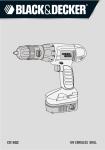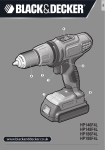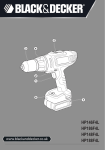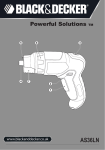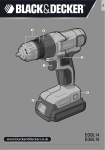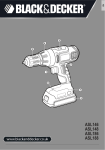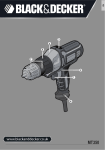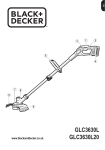Download Black & Decker CDC18GK2-XE Instruction manual
Transcript
90504485 CDC9602,CDC1200 etc 6/19/06 10:39 AM Page 1 C O R DL E S S C O M PAC T DR IL L S INSTRUCTION MANUAL Cataloge Numbers CDC14K2-XE,CDC18K2-XE CDC14GK2-XE,CDC18GK2-XE T HANK YOU FOR CHOOSING B LACK & D ECKER ! BEFORE RETURNING THIS PRODUCT FOR ANY REASON PLEASE CALL 1-800-654-155 BEFORE YOU CALL, HAVE THE CATALOG No. AND DATE CODE AVAILABLE. IN MOST CASES, A BLACK & DECKER REPRESENTATIVE CAN RESOLVE THE PROBLEM OVER THE PHONE. IF YOU HAVE A SUGGESTION OR COMMENT, GIVE US A CALL. YOUR FEEDBACK IS VITAL TO BLACK & DECKER. SAVE THIS MANUAL FOR FUTURE REFERENCE. 90504485 CDC9602,CDC1200 etc 6/19/06 10:39 AM Page 2 General Safety Rules WARNING! Read all instructions. Failure to follow all instructions listed below may result in electric shock, fire and/or serious injury. The term “power tool” in all of the warnings listed below refers to your mains-operated (corded) power tool or battery-operated (cordless) power tool. SAVE THESE INSTRUCTIONS 1) Work area safety a) Keep work area clean and well lit. Cluttered or dark areas invite accidents. b) Do not operate power tools in explosive atmospheres, such as in the presence of flammable liquids, gases or dust. Power tools create sparks which may ignite the dust or fumes. c) Keep children and bystanders away while operating a power tool. Distractions can cause you to lose control 2) Electrical safety a) Power tool plugs must match the outlet. Never modify the plug in any way. Do not use any adapter plugs with earthed (grounded) power tools. Unmodified plugs and matching outlets will reduce risk of electric shock b) Avoid body contact with earthed or grounded surfaces such as pipes, radiators, ranges and refrigerators. There is an increased risk of electric shock if your body is earthed or grounded. c) Do not expose power tools to rain or wet conditions. Water entering a power tool will increase the risk of electric shock d) Do not abuse the cord. Never use the cord for carrying, pulling or unplugging the power tool. Keep cord away from heat, oil, sharp edges or moving parts. Damaged or entangled cords increase the risk of electric shock. e) When operating a power tool outdoors, use an extension cord suitable for outdoor use. Use of a cord suitable for outdoor use reduces the risk of electric shock. 3) Personal safety a) Stay alert, watch what you are doing and use common sense when operating a power tool. Do not use a power tool while you are tired or under the influence of drugs, alcohol or medication. A moment of inattention while operating power tool may result in serious personal injury. b) Use safety equipment. Always wear eye protection. Safety equipment such as dust mask, non-skid safety shoes, hard hat, or hearing protection used for appropriate conditions will reduce personal injuries. c) Avoid accidental starting. Ensure the switch is in the off-position before plugging in. Carrying power tools with your finger on the switch or plugging in power tools that have the switch on invites accidents. d) Remove any adjusting key or wrench before turning the power tool on. A wrench or a key left attached to a rotating part of the power tool may result in personal injury. e) Do not overreach. Keep proper footing and balance at all times. This enables better control of the power tool in unexpected situations. f) Dress properly. Do not wear loose clothing or jewelry. Keep your hair, clothing and gloves away from moving parts. Loose clothes, jewelry or long hair can be caught in moving parts. Air vents often cover moving parts and should also be avoided. g) If devices are provided for the connection of dust extraction and collection facilities, ensure these are connected and properly used. Use of these devices can reduce dust-related hazards. 4) Power tool use and care a) Do not force the power tool. Use the correct power tool for your application. 2 90504485 CDC9602,CDC1200 etc 6/19/06 10:39 AM Page 3 The correct power tool will do the job better and safer at the rate for which it was designed. b) Do not use the power tool if the switch does not turn it on and off. Any power tool that cannot be controlled with the switch is dangerous and must be repaired. c) Disconnect the plug from the power source and/or the battery pack from the power tool before making any adjustments, changing accessories, or storing power tools. Such preventive safety measures reduce the risk of starting the power tool accidentally. d) Store idle power tools out of the reach of children and do not allow persons unfamiliar with the power tool or these instructions to operate the power tool. Power tools are dangerous in the hands of untrained users. e) Maintain power tools. Check for misalignment or binding of moving parts, breakage of parts and any other condition that may affect the power tools operation. If damaged, have the power tool repaired before use. Many accidents are caused by poorly maintained power tools. f) Keep cutting tools sharp and clean. Properly maintained cutting tools with sharp cutting edges are less likely to bind and are easier to control. g) Use the power tool, accessories and tool bits etc., in accordance with these instructions and in the manner intended for the particular type of power tool, taking into account the working conditions and the work to be performed. Use of the power tool for operations different from those intended could result in a hazardous situation. 5) Battery tool use and care a) Ensure the switch is in the off position before inserting battery pack. Inserting the battery pack into power tools that have the switch on invites accidents. b) Recharge only with the charger specified by the manufacturer. A charger that is suitable for one type of battery pack may create a risk of fire when used with another battery pack. c) Use power tools only with specifically designated battery packs. Use of any other battery packs may create a risk of injury and fire. d) When battery pack is not in use, keep it away from other metal objects like paper clips, coins, keys, nails, screws, or other small metal objects that can make a connection from one terminal to another. Shorting the battery terminals together may cause burns or a fire. e) Under abusive conditions, liquid may be ejected from the battery, avoid contact. If contact accidentally occurs, flush with water. If liquid contacts eyes, additionally seek medical help. Liquid ejected from the battery may cause irritation or burns. 6) Service a) Have your power tool serviced by a qualified repair person using only identical replacement parts. This will ensure that the safety of the power tool is maintained. SPECIFIC SAFETY RULES • Wear ear protectors with impact drills. Exposure to noise can cause hearing loss. • Hold tool by insulated gripping surfaces when performing an operation where the cutting tool may contact hidden wiring or its own cord. Contact with a "live" wire will make exposed metal parts of the tool "live" and shock the operator. • When working on a ladder or on scaffolding be sure to lay the tool down on its side when not in use. Some tools with large battery packs will stand upright but may be easily knocked over. • Use clamps or another practical way to secure and support the work piece to a stable platform. Holding the work by hand or against your body leaves it unstable and may lead to loss of control. WARNING: Some dust created by power sanding, sawing, grinding, drilling, and other construction activities contains chemicals known to cause cancer, birth defects or other reproductive harm. Some examples of these chemicals are: 3 90504485 CDC9602,CDC1200 etc 6/19/06 10:39 AM Page 4 • lead from lead-based paints, • crystalline silica from bricks and cement and other masonry products, and • arsenic and chromium from chemically-treated lumber (CCA). Your risk from these exposures varies, depending on how often you do this type of work. To reduce your exposure to these chemicals: work in a well ventilated area, and work with approved safety equipment, such as those dust masks that are specially designed to filter out microscopic particles. • Avoid prolonged contact with dust from power sanding, sawing, grinding, drilling, and other construction activities. Wear protective clothing and wash exposed areas with soap and water. Allowing dust to get into your mouth, eyes, or lay on the skin may promote absorption of harmful chemicals. WARNING: Use of this tool can generate and/or disperse dust, which may cause serious and permanent respiratory or other injury. Always use NIOSH/OSHA approved respiratory protection appropriate for the dust exposure. Direct particles away from face and body. The label on your tool may include the following symbols. V ..........................volts A..........................amperes Hz ........................hertz W ........................watts min ........................minutes ......................alternating current no ........................no load speed ......................direct current ..........................Class II Construction ........................earthing terminal ........................safety alert symbol .../min ..................revolutions or reciprocations per minute FUNCTIONAL DESCRIPTION 1. Variable speed switch 2. Forward/reverse slider 3. Torque adjustment collar 4. Chuck 5. Battery 4 3 1 2 5 BATTERY CAP INFORMATION FIGURE A (Page 5) Battery pack storage and carrying caps (1) are provided for use whenever the battery pack is out of the tool or charger. Remove cap before placing battery pack in charger or tool. WARNING: Do not store or carry battery pack so that metal objects can contact exposed battery pack terminals. For example, do not place battery pack in aprons, pockets, tool boxes, product kit boxes, drawers, etc. with loose nails, screws, keys, etc. without battery cap. Transporting batteries can possibly cause fires if the battery pack terminals inadvertently come in contact with conductive materials such as keys, coins, hand tools and the like. The US Department of Transportation Hazardous Material Regulations (HMR) actually prohibit transporting batteries in commerce or on airplanes (i.e. packed in suitcases and carryon luggage) UNLESS they are properly protected from short circuits. So when transporting individual batteries, make sure that the battery pack terminals are protected and well insulated from materials that could contact them and cause a short circuit. 4 90504485 CDC9602,CDC1200 etc 6/19/06 10:39 AM Page 5 6 A B C 7 5 k n la B E D 2 10 F 1 G 3 4 5 90504485 CDC9602,CDC1200 etc 6/19/06 10:39 AM Page 6 SAFETY WARNINGS AND INSTRUCTIONS: CHARGING 1. This manual contains important safety and operating instructions. 2. Before using battery charger, read all instructions and cautionary markings on battery charger, battery pack, and product using battery pack. 3. CAUTION: To reduce the risk of injury, charge only Black & Decker Batteries. Other types of batteries may burst causing personal injury and damage. 4. Do not expose charger to rain or snow. 5. Use of an attachment not recommended or sold by Black & Decker may result in a risk of fire, electric shock, or injury to persons. 6. To reduce risk of damage to electric plug and cord, pull by plug rather than cord when disconnecting charger. 7. Make sure cord is located so that it will not be stepped on, tripped over, or otherwise subjected to damage or stress. 8. An extension cord should not be used unless absolutely necessary. Use of improper extension cord could result in a risk of fire, electric shock or electrocution. a. Two-wire cords can be used with 2-wire or 3-wire extension cords. Only round jacketed extension cords should be used, and we recommend that they be listed by Underwriters Laboratories (U.L.). If the extension is to be used outside, the cord must be suitable for outdoor use. Any cord marked for outdoor use can also be used for indoor work. The letters "W" or "WA" on the cord jacket indicate that the cord is suitable for outdoor use. b. An extension cord must have adequate wire size (AWG or American Wire Gauge) for safety, and to prevent loss of power and overheating. The smaller the gauge number of the wire, the greater the capacity of the cable; that is, 16 gauge has more capacity than 18 gauge. When using more than one extension to make up the total length, be sure each extension contains at least the minimum wire size. 9. Use only the supplied charger when charging your drill. The use of any other charger could damage the drill or create a hazardous condition. 10. Use only one charger when charging. 11. Do not attempt to open the charger. There are no customer serviceable parts inside. Return to any authorized Black & Decker service center. 12. DO NOT incinerate the battery pack even if they are severely damaged or completely worn out. The battery pack can explode in a fire. 13. A small leakage of liquid from the battery pack cells may occur under extreme usage, charging or temperature conditions. This does not indicate a failure. However, if the outer seal is broken and this leakage gets on your skin: a. Wash quickly with soap and water. b. Neutralize with a mild acid such as lemon juice or vinegar. c. If the battery liquid gets in your eyes, flush them with clean water for a minimum of 10 minutes and seek immediate medical attention. MEDICAL NOTE: The liquid is a 25-35% solution of potassium hydroxide. 6 90504485 CDC9602,CDC1200 etc 6/19/06 10:39 AM Page 7 CHARGING THE BATTERY PACK FIGURE B THE BATTERY PACK IS NOT FULLY CHARGED AT THE FACTORY. BEFORE ATTEMPTING TO CHARGE THE BATTERY PACK, THOROUGHLY READ ALL OF THE SAFETY INSTRUCTIONS. The charger is designed to use standard household 230 volt 50 Hz power. 1. Plug the charger (7) into any standard 230 Volt 50 Hz electrical outlet.NOTE: Do not charge by means of an engine generator or DC power source. Use only 230V AC 2. Slide the charger onto the battery pack (5) as shown in figure B and let the battery pack charge initially for 9 hours . After the initial charge, under normal usage, your battery pack should be fully charged in 3 to 9 hours . 3. Unplug charger, and remove the battery pack. Place the battery pack in the tool and be certain that it is inserted fully into the tool cavity until it “clicks” into place. NOTE: To remove the battery pack from the drill, press down on the release button (10) on the back of the battery pack (figure D) and slide out. IMPORTANT CHARGING NOTES 1. After normal usage, your battery pack should be fully charged in 3 to 9 hours. If the battery pack is run-down completely, it may take up to 9 hours to become fully charged. Your battery pack was sent from the factory in an uncharged condition. Before attempting to use it, it must be charged for at least 9 hours. 2. DO NOT charge the battery pack in an air temperature below 40°F (4,5 °C) or above 105°F.(40,5 °C) This is important and will prevent serious damage to the battery pack. Longest life and best performance can be obtained if battery pack is charged when air temperature is about 75°F.(24°C). 3. While charging, the charger may hum and become warm to touch. This is a normal condition and does not indicate a problem. 4. If the battery pack does not charge properly—(1) Check current at receptacle by plugging in a lamp or other appliance. (2) Check to see if receptacle is connected to a light switch which turns power off when you turn out the lights. (3) Move charger and battery pack to a surrounding air temperature of 40°F (4,5 °C) to 105°F.(40,5 °C) (4) If the receptacle and temperature are OK, and you do not get proper charging, take or send the battery pack and charger to your local Black & Decker service center. See Tools Electric in yellow pages. 5. The battery pack should be recharged when it fails to produce sufficient power on jobs which were easily done previously. DO NOT CONTINUE using product with its battery pack in a depleted condition. 6. To prolong battery life, avoid leaving the battery pack on charge for extended periods of time (over 30 days without use). Although overcharging is not a safety concern, it can significantly reduce overall battery life. 7. The battery pack will reach optimum performance after being cycled 5 times during normal usage. There is no need to run the batteries down completely before recharging. Normal usage is the best method of discharging and recharging the batteries. SAFETY WARNINGS AND INSTRUCTIONS: DRILLS 1. Hold drill firmly with one hand on the grip and the other hand on the bottom of the battery pack. 2. When attaching accessories in the drill chuck, hand tighten the keyless chuck firmly. WARNING: Drill may stall (if overloaded or improperly used) causing a twist. Always expect the stall. Grip the drill firmly with both hands to control the twisting action and prevent loss of control which could cause personal injury. If a stall does occur, release the trigger immediately and determine the reason for the stall before re-starting. • Young children and the infirm. This appliance is not intended for use by young children or infirm persons without supervision. Young children should be supervised to ensure that they do not play with this appliance. • Replacement of the supply cord. If t he supply cord is damaged, it must be replaced by the manufacturer or an authorised Black & Decker Service Centre in order to avoid a hazard. 7 90504485 CDC9602,CDC1200 etc 6/19/06 10:39 AM Page 8 OPERATING INSTRUCTIONS TRIGGER SWITCH & REVERSING BUTTON (FIGURE E) • The drill is turned ON and OFF by pulling and releasing the trigger switch (1). The farther the trigger is depressed, the higher the speed of the drill. • A forward/reverse control button (2) determines the direction of the tool and also serves as a lock off button. • To select forward rotation, release the trigger switch and depress the forward/reverse control button to the left. • To select reverse, depress the forward/reverse control button the opposite direction. NOTE: The center position of the control button locks the tool in the off position. When changing the position of the control button, be sure the trigger is released. TORQUE CONTROL (FIGURE F) This tool is fitted with a collar (3) to select the operating mode and to set the torque for tightening screws. Large screws and hard workpiece materials require a higher torque setting than small screws and soft workpiece materials. • For drilling in wood, metal and plastics, set the collar to the drilling position symbol . • For screwdriving, set the collar to the desired setting. If you do not yet know the appropriate setting, proceed as follows: • Set the collar to the lowest torque setting. • Tighten the first screw. • If the clutch ratchets before the desired result is achieved, increase the collar setting and continue tightening the screw. Repeat until you reach the correct setting. Use this setting for the remaining screws. KEYLESS CHUCK (FIGURE G) To insert a drill bit or other accessory: 1. Grasp the rear half of the chuck (4) with one hand and use your other hand to rotate the front half in the counterclockwise direction, as viewed from the chuck end. 2. Insert the bit or other accessory fully into the chuck, and tighten securely by holding the rear half of the chuck and rotating the front portion in the clockwise direction as viewed from the chuck end. WARNING: Do not attempt to tighten drill bits (or any other accessory) by gripping the front part of the chuck and turning the tool on. Damage to the chuck and personal injury may occur when changing accessories. SCREW DRIVING For driving fasteners, the reversing button should be pushed to the left. Use reverse (button pushed to the right) for removing fasteners. When moving from forward to reverse, or vice versa, always release the trigger switch first. ON BOARD BIT STORAGE A bit storage slot is built-in to the area just above the battery pack. DRILLING • Use sharp drill bits only. • Support and secure work properly, as instructed in the Safety Instructions. • Use appropriate and required safety equipment, as instructed in the Safety Instructions. • Secure and maintain work area, as instructed in the Safety Instructions. • Run the drill very slowly, using light pressure, until the hole is started enough to keep the drill bit from slipping out of it. • Apply pressure in a straight line with the bit. Use enough pressure to keep the bit biting but not so much as to stall the motor or deflect the bit. • Hold the drill firmly with two hands to control its twisting action. • DO NOT CLICK THE TRIGGER OF A STALLED DRILL OFF AND ON IN AN ATTEMPT TO START IT. DAMAGE TO THE DRILL CAN RESULT. • Minimize stalling on breakthrough by reducing pressure and slowly drilling through the last part of the hole. • Keep the motor running while pulling the bit out of a drilled hole. This will help reduce jamming. • Make sure switch turns drill on and off. 8 90504485 CDC9602,CDC1200 etc 6/19/06 10:39 AM Page 9 MAINTENANCE Use only mild soap and damp cloth to clean the tool. Never let any liquid get inside the tool; never immerse any part of the tool into a liquid. IMPORTANT: To assure product SAFETY and RELIABILITY, repairs, maintenance and adjustment (other than those listed in this manual) should be performed by authorized service centers or other qualified service personnel, always using identical replacement parts. Problem • Unit will not start. TROUBLESHOOTING Possible Cause • Battery pack not installed properly. Possible Solution • Check battery pack installation. • Battery pack not charged. • Check battery pack charging requirements. • Battery pack will not charge. • Battery pack not inserted into charger. • Insert battery pack into charger until red LED appears. • Charger not plugged in. • Plug charger into a working outlet. Refer to “Important Charging Notes” for more details. • Check current at receptacle by plugging in a lamp or other appliance. • Check to see if receptacle is connected to a light switch which turns power off when you turn out the lights. • Surrounding air temperature • Move charger and battery too hot or too cold. pack to a surrounding air temperature of above 40 degrees F (4,5°C) or below 105 degrees F (+40,5°C). For assistance with your product, visit our website www.blackanddecker.com for the location of the service center nearest you or call the BLACK & DECKER help line at 1-800-654-155. Accessories Recommended accessories for use with your tool are available from your local dealer or authorized service center. If you need assistance regarding accessories, please call: 1-800-654-144. WARNING: The use of any accessory not recommended for use with this tool could be hazardous. 9 90504485 CDC9602,CDC1200 etc 6/19/06 10:39 AM Page 10 SERVICE INFORMATION All Black & Decker Service Centers are staffed with trained personnel to provide customers with efficient and reliable power tool service. Whether you need technical advice, repair, or genuine factory replacement parts, contact the Black & Decker location nearest you. To find your local service location, refer to the yellow page directory under "Tools—Electric" or call: 1-800-654-155 or visit www.blackanddecker.com.au AUSTRALIA AND NEW ZEALAND 2 YEAR REPAIR GUARANTEE Black & Decker welcomes you as a purchaser of this product from our range of Home Workshop, Garden tools and Accessories. All our products are engineered and manufactured to ensure the highest standards of reliability and performance during use, and are supported in After Sales Service by a wide network of Black & Decker Authorised Service Centers. BLACK & DECKER SUPPLEMENTARY GUARANTEE Subject to conditions stated below, Black & Decker guarantees that it will correct by repair or parts replacement, without charge, any defect in the product this Guarantee Card accompanies arising from faulty workmanship or materials where such defect arises within two years from the date of purchase of the product. A product subject to claim under this guarantee should be returned as a complete unit to the most convenient Black & Decker Authorised Service Centre or Agent. CONDITIONS The Black & Decker Supplementary Guarantee does not apply in the following cases: • where the product has been used for trade or industrial purposes: • where any defect or failure is attributed to accident, misuse, abuse, negligence or nonobservance of local regulations on the part of the owner or user: or • where the product has been serviced by a person not authorized by Black & Decker to do so, or with non approved parts: or • to loose accessories. In order to enforce the Black & Decker Supplementary Guarantee, proof of purchase is required (Guarantee Card and or store receipt). The period of the Black & Decker Supplementary Guarantee begins from the original date of purchase not withstanding any subsequent repair or parts replacement. No guarantees other than contained in this document, whether written or verbal, are authorized to be made on behalf of Black & Decker. All other conditions and guarantees whether expressed or implied by law, are, to the extent permitted by law, hereby excluded. The Black & Decker Supplementary Guarantee does not apply outside Australia and New Zealand. PURCHASERS STATUTORY RIGHTS The Black & Decker Supplementary Guarantee set out above does not exclude any conditions or guarantees that may be mandatorily implied by law, and your attention is drawn to the provisions of the Consumer Guarantee Act 1993 (New Zealand only), Trade Practices Act 1974 and State legislation (Australia only), which confers rights upon consumers. The Black & Decker Supplementary Guarantee is in addition to any rights conferred on a consumer under the Act, where applicable and any other rights provided under applicable legislation. 10 90504485 CDC9602,CDC1200 etc 6/19/06 10:39 AM Page 11 Black&Decker New Zealand 5 Te Apunga Place MT WELLINGTON NEW ZEALAND Tel: 64 9 259 1111 Fax: 64 9 259 1122 Black&Decker (Australia) PTY.LTD. 20 Fletcher Road Mooroolbark 3138 Victoria Australia Tel: (61 3)8720 5100 Fax:(61 3)9727 5940 Service Department: Tel: 1800-654-155 11












